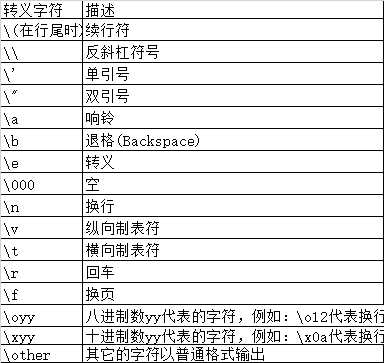python格式化输出
Posted arxive
tags:
篇首语:本文由小常识网(cha138.com)小编为大家整理,主要介绍了python格式化输出相关的知识,希望对你有一定的参考价值。
转自fat39原文 python基础_格式化输出(%用法和format用法)
%o —— oct 八进制
%d —— dec 十进制
%x —— hex 十六进制
1 >>> print(‘%o‘ % 20) 2 24 3 >>> print(‘%d‘ % 20) 4 20 5 >>> print(‘%x‘ % 20) 6 14
2、浮点数输出
(1)格式化输出
%f ——保留小数点后面六位有效数字
%.3f,保留3位小数位
%e ——保留小数点后面六位有效数字,指数形式输出
%.3e,保留3位小数位,使用科学计数法
%g ——在保证六位有效数字的前提下,使用小数方式,否则使用科学计数法
%.3g,保留3位有效数字,使用小数或科学计数法
1 >>> print(‘%f‘ % 1.11) # 默认保留6位小数 2 1.110000 3 >>> print(‘%.1f‘ % 1.11) # 取1位小数 4 1.1 5 >>> print(‘%e‘ % 1.11) # 默认6位小数,用科学计数法 6 1.110000e+00 7 >>> print(‘%.3e‘ % 1.11) # 取3位小数,用科学计数法 8 1.110e+00 9 >>> print(‘%g‘ % 1111.1111) # 默认6位有效数字 10 1111.11 11 >>> print(‘%.7g‘ % 1111.1111) # 取7位有效数字 12 1111.111 13 >>> print(‘%.2g‘ % 1111.1111) # 取2位有效数字,自动转换为科学计数法 14 1.1e+03
(2)内置round()
round(number[, ndigits])
参数:
number - 这是一个数字表达式。
ndigits - 表示从小数点到最后四舍五入的位数。默认值为0。
返回值
该方法返回x的小数点舍入为n位数后的值。
round()函数只有一个参数,不指定位数的时候,返回一个整数,而且是最靠近的整数,类似于四舍五入,当指定取舍的小数点位数的时候,一般情况也是使用四舍五入的规则,但是碰到.5的情况时,如果要取舍的位数前的小数是奇数,则直接舍弃,如果是偶数则向上取舍。
注:“.5”这个是一个“坑”,且python2和python3出来的接口有时候是不一样的,尽量避免使用round()函数吧
1 >>> round(1.1125) # 四舍五入,不指定位数,取整 2 1 3 >>> round(1.1135,3) # 取3位小数,由于3为奇数,则向下“舍” 4 1.113 5 >>> round(1.1125,3) # 取3位小数,由于2为偶数,则向上“入” 6 1.113 7 >>> round(1.5) # 无法理解,查阅一些资料是说python会对数据进行截断,没有深究 8 2 9 >>> round(2.5) # 无法理解 10 2 11 >>> round(1.675,2) # 无法理解 12 1.68 13 >>> round(2.675,2) # 无法理解 14 2.67 15 >>>
3、字符串输出
%s
%10s——右对齐,占位符10位
%-10s——左对齐,占位符10位
%.2s——截取2位字符串
%10.2s——10位占位符,截取两位字符串
1 >>> print(‘%s‘ % ‘hello world‘) # 字符串输出 2 hello world 3 >>> print(‘%20s‘ % ‘hello world‘) # 右对齐,取20位,不够则补位 4 hello world 5 >>> print(‘%-20s‘ % ‘hello world‘) # 左对齐,取20位,不够则补位 6 hello world 7 >>> print(‘%.2s‘ % ‘hello world‘) # 取2位 8 he 9 >>> print(‘%10.2s‘ % ‘hello world‘) # 右对齐,取2位 10 he 11 >>> print(‘%-10.2s‘ % ‘hello world‘) # 左对齐,取2位 12 he
4、其他
(1)字符串格式代码

(2)常用转义字符

format用法
相对基本格式化输出采用‘%’的方法,format()功能更强大,该函数把字符串当成一个模板,通过传入的参数进行格式化,并且使用大括号‘’作为特殊字符代替‘%’
位置匹配
(1)不带编号,即“”
(2)带数字编号,可调换顺序,即“1”、“2”
(3)带关键字,即“a”、“tom”
1 >>> print(‘ ‘.format(‘hello‘,‘world‘)) # 不带字段 2 hello world 3 >>> print(‘0 1‘.format(‘hello‘,‘world‘)) # 带数字编号 4 hello world 5 >>> print(‘0 1 0‘.format(‘hello‘,‘world‘)) # 打乱顺序 6 hello world hello 7 >>> print(‘1 1 0‘.format(‘hello‘,‘world‘)) 8 world world hello 9 >>> print(‘a tom a‘.format(tom=‘hello‘,a=‘world‘)) # 带关键字 10 world hello world >>> ‘0, 1, 2‘.format(‘a‘, ‘b‘, ‘c‘) ‘a, b, c‘ >>> ‘, , ‘.format(‘a‘, ‘b‘, ‘c‘) # 3.1+版本支持 ‘a, b, c‘ >>> ‘2, 1, 0‘.format(‘a‘, ‘b‘, ‘c‘) ‘c, b, a‘ >>> ‘2, 1, 0‘.format(*‘abc‘) # 可打乱顺序 ‘c, b, a‘ >>> ‘010‘.format(‘abra‘, ‘cad‘) # 可重复 ‘abracadabra‘ >>> ‘Coordinates: latitude, longitude‘.format(latitude=‘37.24N‘, longitude=‘-115.81W‘) ‘Coordinates: 37.24N, -115.81W‘ >>> coord = ‘latitude‘: ‘37.24N‘, ‘longitude‘: ‘-115.81W‘ >>> ‘Coordinates: latitude, longitude‘.format(**coord) ‘Coordinates: 37.24N, -115.81W‘ >>> c = 3-5j >>> (‘The complex number 0 is formed from the real part 0.real ‘ ... ‘and the imaginary part 0.imag.‘).format(c) ‘The complex number (3-5j) is formed from the real part 3.0 and the imaginary part -5.0.‘ >>> class Point: ... def __init__(self, x, y): ... self.x, self.y = x, y ... def __str__(self): ... return ‘Point(self.x, self.y)‘.format(self=self) ... >>> str(Point(4, 2)) ‘Point(4, 2)‘ >>> >>> coord = (3, 5) >>> ‘X: 0[0]; Y: 0[1]‘.format(coord) ‘X: 3; Y: 5‘ >>> a = ‘a‘: ‘test_a‘, ‘b‘: ‘test_b‘ >>> ‘X: 0[a]; Y: 0[b]‘.format(a) ‘X: test_a; Y: test_b‘
格式转换
‘b‘ - 二进制。将数字以2为基数进行输出。
‘c‘ - 字符。在打印之前将整数转换成对应的Unicode字符串。
‘d‘ - 十进制整数。将数字以10为基数进行输出。
‘o‘ - 八进制。将数字以8为基数进行输出。
‘x‘ - 十六进制。将数字以16为基数进行输出,9以上的位数用小写字母。
‘e‘ - 幂符号。用科学计数法打印数字。用‘e‘表示幂。
‘g‘ - 一般格式。将数值以fixed-point格式输出。当数值特别大的时候,用幂形式打印。
‘n‘ - 数字。当值为整数时和‘d‘相同,值为浮点数时和‘g‘相同。不同的是它会根据区域设置插入数字分隔符。
‘%‘ - 百分数。将数值乘以100然后以fixed-point(‘f‘)格式打印,值后面会有一个百分号。
1 >>> print(‘0:b‘.format(3)) 2 11 3 >>> print(‘:c‘.format(20)) 4 5 >>> print(‘:d‘.format(20)) 6 20 7 >>> print(‘:o‘.format(20)) 8 24 9 >>> print(‘:x‘.format(20)) 10 14 11 >>> print(‘:e‘.format(20)) 12 2.000000e+01 13 >>> print(‘:g‘.format(20.1)) 14 20.1 15 >>> print(‘:f‘.format(20)) 16 20.000000 17 >>> print(‘:n‘.format(20)) 18 20 19 >>> print(‘:%‘.format(20)) 20 2000.000000% 21 >>>
进阶用法
进制转换
>>> # format also supports binary numbers >>> "int: 0:d; hex: 0:x; oct: 0:o; bin: 0:b".format(42) ‘int: 42; hex: 2a; oct: 52; bin: 101010‘ >>> # with 0x, 0o, or 0b as prefix: >>> "int: 0:d; hex: 0:#x; oct: 0:#o; bin: 0:#b".format(42) # 在前面加“#”,则带进
左中右对齐及位数补全
(1)< (默认)左对齐、> 右对齐、^ 中间对齐、= (只用于数字)在小数点后进行补齐
(2)取位数“:4s”、":.2f"等
>>> print(‘ and ‘.format(‘hello‘,‘world‘)) # 默认左对齐 hello and world >>> print(‘:10s and :>10s‘.format(‘hello‘,‘world‘)) # 取10位左对齐,取10位右对齐 hello and world >>> print(‘:^10s and :^10s‘.format(‘hello‘,‘world‘)) # 取10位中间对齐 hello and world >>> print(‘ is :.2f‘.format(1.123,1.123)) # 取2位小数 1.123 is 1.12 >>> print(‘0 is 0:>10.2f‘.format(1.123)) # 取2位小数,右对齐,取10位 1.123 is 1.12 >>> ‘:<30‘.format(‘left aligned‘) # 左对齐 ‘left aligned ‘ >>> ‘:>30‘.format(‘right aligned‘) # 右对齐 ‘ right aligned‘ >>> ‘:^30‘.format(‘centered‘) # 中间对齐 ‘ centered ‘ >>> ‘:*^30‘.format(‘centered‘) # 使用“*”填充 ‘***********centered***********‘ >>>‘:0=30‘.format(11) # 还有“=”只能应用于数字,这种方法可用“>”代替 ‘000000000000000000000000000011‘
正负符号显示
>>> ‘:+f; :+f‘.format(3.14, -3.14) # 总是显示符号
‘+3.140000; -3.140000‘
>>> ‘: f; : f‘.format(3.14, -3.14) # 若是+数,则在前面留空格
‘ 3.140000; -3.140000‘
>>> ‘:-f; :-f‘.format(3.14, -3.14) # -数时显示-,与‘:f; :f‘一致
‘3.140000; -3.140000‘
百分数%
>>> points = 19
>>> total = 22
>>> ‘Correct answers: :.2%‘.format(points/total)
‘Correct answers: 86.36%‘
时间
>>> import datetime
>>> d = datetime.datetime(2010, 7, 4, 12, 15, 58)
>>> ‘:%Y-%m-%d %H:%M:%S‘.format(d)
‘2010-07-04 12:15:58‘
逗号","分隔金钱,没以前进位
>>> ‘:,‘.format(1234567890)
‘1,234,567,890‘
占位符嵌套
>>> for align, text in zip(‘<^>‘, [‘left‘, ‘center‘, ‘right‘]):
... ‘0:fillalign16‘.format(text, fill=align, align=align)
...
‘left<<<<<<<<<<<<‘
‘^^^^^center^^^^^‘
‘>>>>>>>>>>>right‘
>>>
>>> octets = [192, 168, 0, 1]
>>> ‘:02X:02X:02X:02X‘.format(*octets)
‘C0A80001‘
>>> int(_, 16) # 官方文档给出来的,无法在IDLE复现
3232235521
>>>
>>> width = 5
>>> for num in range(5,12):
... for base in ‘dXob‘:
... print(‘0:widthbase‘.format(num, base=base, width=width), end=‘ ‘)
... print()
...
5 5 5 101
6 6 6 110
7 7 7 111
8 8 10 1000
9 9 11 1001
10 A 12 1010
11 B 13 1011
占位符%s和%r
"""
replacement_field ::= "" [field_name] ["!" conversion] [":" format_spec] ""
conversion ::= "r" | "s" | "a"
这里只有三个转换符号,用"!"开头。
"!r"对应 repr();"!s"对应 str(); "!a"对应ascii()。
"""
>>> "repr() shows quotes: !r; str() doesn‘t: !s".format(‘test1‘, ‘test2‘)
"repr() shows quotes: ‘test1‘; str() doesn‘t: test2" # 输出结果是一个带引号,一个不带# a.format(b)
>>> "0 1".format("hello","world")
‘hello world‘
# f"xxxx"
# 可在字符串前加f以达到格式化的目的,在里加入对象,此为format的另一种形式:
>>> a = "hello"
>>> b = "world"
>>> f"a b"
‘hello world‘
name = ‘jack‘
age = 18
sex = ‘man‘
job = "IT"
salary = 9999.99
print(f‘my name is name.capitalize().‘)
print(f‘I am age:*^10 years old.‘)
print(f‘I am a sex‘)
print(f‘My salary is salary:10.3f‘)
# 结果
my name is Jack.
I am ****18**** years old.
I am a man
My salary is 9999.990
以上是关于python格式化输出的主要内容,如果未能解决你的问题,请参考以下文章